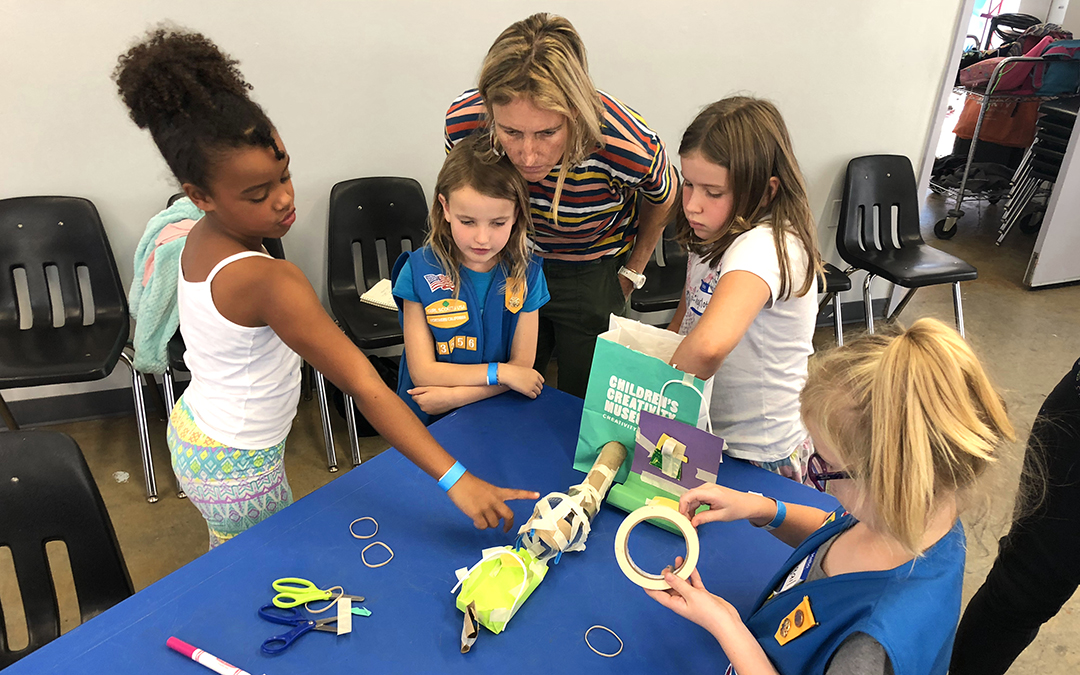Have you started a Girl Scout Journey yet? Journeys begin with impactful skill-building activities, combining playful methods with real learning. Practice engineering and problem-solving by designing an assistive device to reach new heights; build communication and computational thinking skills with a paper & pencil “unplugged” drawing game; raise your antennae, make observations, and collect data to help researchers by contributing to a SciStarter project after you set a picnic for ants. These are some of the activities your girls can dive into with the Think Like A… STEM Journeys! As the Journey progresses, girls continue to develop their leadership skills, applying their new skills and knowledge to help their community in a Take Action project.
The three STEM Journeys released in fall 2018 offer girls the opportunity to Think Like an Engineer, Think Like a Programmer, or Think Like a Citizen Scientist. So let’s get started!
Step 1: Review the Journey Materials
Designed to be completed in six 90-minute meetings, Journeys are a popular “award-in-a-weekend” program for troops and service unit events. They are available for all levels of Girl Scouts, including multilevel troops! In completing each Journey, girls earn 2 embroidered award badges. The first award is focused on STEM content and skill-building and is completed in the first three meetings. The second award, Take Action, is completed in the final three meetings, where girls plan and execute their Take Action project.
You won’t find these Journey books in the store—because the new STEM Journey materials are totally free and available online! Meeting scripts are available to leaders using the Volunteer Toolkit (VTK), with STEM webinars, STEM badge info, and tip sheets available to all GSNorCal members on the STEM Learning Portal page.
Step 2: Choose Your STEM Journey
There are three STEM Journeys: Think Like an Engineer (K–12), which has girls tackling hands-on challenges to learn how to innovate, design, and build; Think Like a Programmer (K–12), which teaches girls problem-solving through interactive computational-thinking activities, and Think Like a Citizen Scientist (K–5), which has girls undertake a citizen science project, making observations, collecting data, and working with scientists. But how to pick which Journey to start with? Answer these simple questions to find out what’s right for your girls:
Do your girls like to make things with their hands? Try Think Like an Engineer
An engineer is someone who designs, builds, or maintains engines, machines, or public works like bridges, skyscrapers, and more! In this Journey, your girls will design and build simple machines to meet a need or solve a problem. Tackle design challenges, use your imagination, troubleshoot your inventions, and engineer solutions to make the world a better place. Girls who Think Like an Engineer enjoy finding out how things work and making them better!
For Daisies, Brownies, and Juniors: Think Like an Engineer Journey: Meeting Overview for Younger Girls (PDF)
For Cadettes, Seniors, and Ambassadors: Think Like an Engineer Journey: Meeting Overview for Older Girls (PDF)
Pro Tip: The best way to set your teams of girls up to complete their activities? Grab some paper bags! Called “Mystery Bags” at the Children’s Creativity Museum’s Engineering Journey program, these bags, each filled with all the materials a team of girls needs to complete the activity, make set up fast and easy. The bags also create an air of excitement by hinting at the surprises to come with each design challenge. Bags with handles are especially helpful for carrying inventions home.
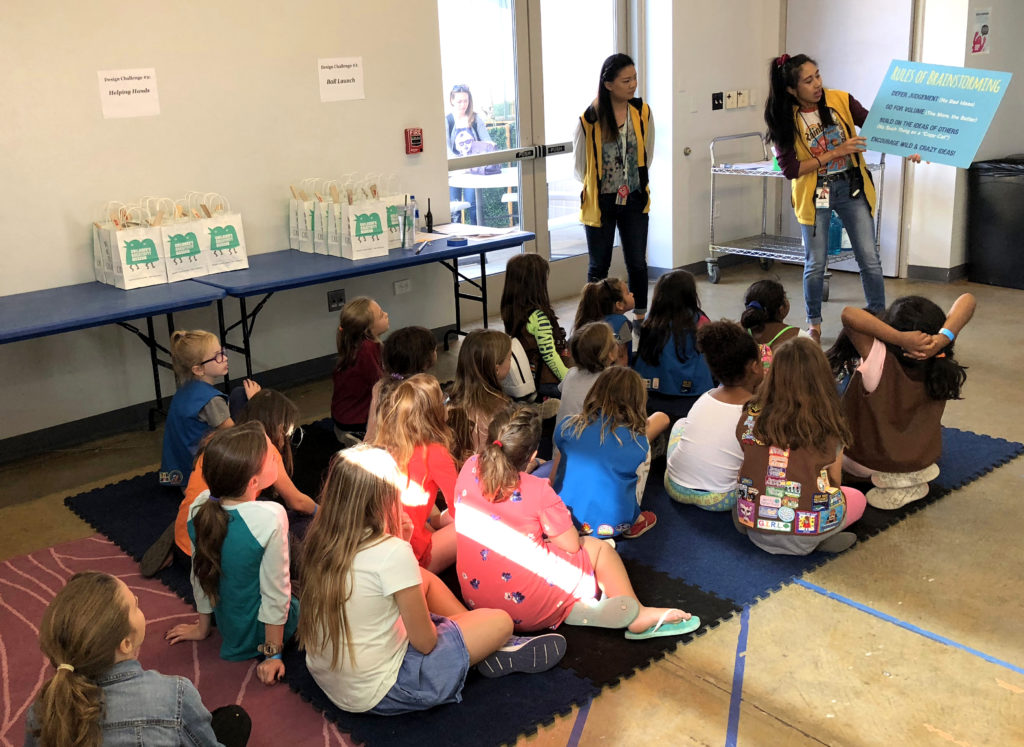
Are your girls excited to solve problems? Try Think Like a Programmer (No computers needed!)
A programmer writes computer programs, which are sets of instructions that tells a computer what to do and how to do it. Learn how to use computational thinking to break down problems, make specific plans, and design solutions. Tackle code challenges with paper and pencil, or play games where you “program” another Girl Scout. Girls who Think Like a Programmer know how to tackle challenges with thoughtful, clear planning.

For Daisies, Brownies, and Juniors: Think Like a Programmer Journey: Meeting Overview for Younger Girls (PDF)
For Cadettes, Seniors, and Ambassadors: Think Like a Programmer Journey: Meeting Overview for Older Girls (PDF)
Pro Tip: Be sure to check out the helpful resources from code.org that are listed in the leader meeting scripts section of the Volunteer Toolkit (VTK). Videos and worksheets prepare any leader—even one who has never written a line of code—to support girls as they build programming skills.
Are your girls outdoorsy, keen observers? Try Think Like a Citizen Scientist
A citizen scientist is someone who applies the scientific method, collecting and analyzing data and collaborating with professional scientists. Daisies, Brownies, and Juniors will get to practice making observations, collecting data, and analyzing their results, before contributing to a citizen science project of their choosing using SciStarter. Along the way, girls build confidence with the scientific method and strengthen their connection with nature.
For Daisies, Brownies, and Juniors: Think Like a Citizen Scientist Journey: Meeting Overview for Younger Girls (PDF)
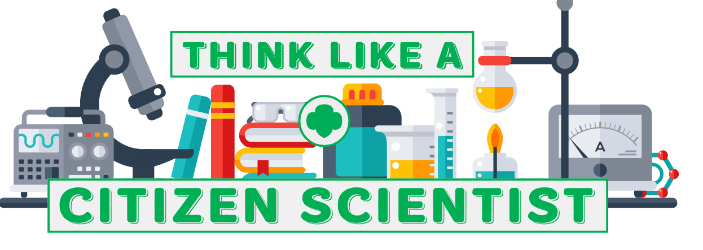
Pro Tip: Start with the VTK, then use the Girl Scouts SciStarter page to create your leader account. This special portal features a curated a list of projects that are best suited for a Girl Scout Journey and allows your girls to contribute data as a troop.
Step 3: Plan Your Take Action Project
Like all Girl Scout Journeys, the second part of each Think Like A… Journey has the girls plan and implement a Take Action project. After girls identify a problem in the community, they brainstorm solutions, design a plan, and implement a solution that makes a lasting positive difference.
Not sure where to start? The Journey meeting scripts and Take Action Guides light the way. You’ll notice in VTK meeting materials, the first three meeting plans include time for girls to brainstorm their Take Action project. Try to create a space where girls can share all of their ideas, regardless of feasibility. In meeting four, girls design a plan, taking constraints into account, such as time or money. In meeting five, girls complete their Take Action project. Some troops find they need more time, so choose to add a meeting, or take time in meeting six to complete the project, before reflecting on all they’ve learned (a very important step!) and celebrate their accomplishment.
Pro Tip: Don’t let those unused Take Action ideas go to waste. Encourage girls to keep a “wild idea” journal to capture all the amazing things they think up—it may be a great idea for another time, like a higher award project!
Whether your girls want to Think Like an Engineer, Think like a Programmer, or Think like a Citizen Scientist, you’ll be exposing them to the creativity, persistence, and inspiration of STEM. Who knows how many budding scientists, programmers, and innovators you’ll be setting on the path to success! Try one out, and see where the Journey takes you!
What to do next:
- Learn more about STEM Journeys, including sample activities by watching the webinar recording or perusing the slide deck.
- Visit the GSNorCal STEM Learning Portal for STEM Journey overviews, past webinar recordings, and helpful resources on a variety of STEM topics.
- Looking for related reads? Check out our other STEM-themed blog posts on The Trailhead.
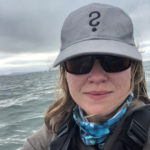
Jessica Henricks—Jessica is a STEM Program Manager for Girl Scouts of Northern California, where she develops and supports NASA-funded Girl Scout Stars space science programs and STEAM experiences. She fondly remembers sleeping outdoors for the first time at Girl Scout Camp Hidden Falls. Before joining Girl Scouts, Jessica created resources, media, and events with organizations like the Exploratorium and Maker Media. In her spare time, she enjoys tinkering in the workshop or going for a paddle on the bay.
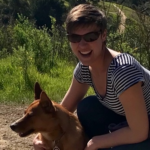
Elspeth Kersh—Elspeth is a STEM Program Manager for Girl Scouts of Northern California, where she develops and supports all kinds of STEM experiences for girls. Before joining the Girl Scouts, Elspeth worked as an educator at the Lawrence Hall of Science and the Oakland Zoo. When she is not at the Girl Scouts office in Alameda, she can be found fishing with her husband, trying new recipes, and singing silly camp songs.

